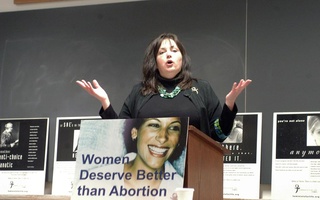To the editors:
On Feb. 3, in “Rebuffing the Buffer Zones,” the Crimson staff urged the Massachusetts Supreme Court “to err on the side of the freedom of speech.” Experience has taught me that the 35-foot buffer zone around abortion clinics in Massachusetts places no inhibition on freedom of speech.
Last summer, I found myself in need of the emergency contraception pill and thanked my lucky stars that I live in an era when such services are readily available. At 7:15 a.m. on a Saturday morning, I arrived at Planned Parenthood on Constitution Avenue in Boston. Around the door in a semi-circle with a 35-foot diameter stood a group of geriatric protestors. I was impressed—I felt industrious for having googled “Planned Parenthood” before 7 a.m. These fine citizens had already managed to print out huge signs with pictures of dead babies, botched abortions, and smiling infants with red “X”s across their faces. One kind gentleman went so far as to shake a bloody Crucifix in my direction, yelling, “You don’t have to do this! There is another way!” Others yelled “slut,” “you’ll burn,” and “please, think of the children!”
Now, I’m no Constitutional expert, but these folks’ speech did not seem particularly restricted. Freedom of speech is a right guaranteed by the First Amendment. The Fourteenth Amendment guarantees equal protection under the law. I’m sure that if it were common practice to protest prostate exams, then buffer zones would be mandated around urology clinics. But we live in a society where I published this anonymously due to fear of retribution, and women who seek reproductive healthcare are subject to public scrutiny and eternal damnation.
Freedom of speech is vital, and the risk of being publicly insulted is the price we pay for it. The buffer zone still makes it possible for people to insult and shame individuals who are simply trying to seek medical care. It also critically protects those individuals from intimidation and possible physical harm.
The Crimson editorial attempted to pull on the heartstrings of readers by citing Benjamin Franklin and “a peaceful, 77-year-old lady” who just wants to protest abortion clinics from a few yards closer. But—sorry not sorry—I don’t feel bad that the people who want to call me a slut have to strain their voices.
Anonymous
Editors' note: The author of the preceding letter has been granted anonymity due to the intensely personal nature of the letter's content.
To the editor:
Upon reading the Feb. 3 staff editorial, “Rebuffing the Buffer Zones,” I am hurt and appalled. This staff editorial implies that all abortion protesters should be entitled to get within a few feet of women seeking abortions in Massachusetts. This assertion, based purely on a shaky application of the First Amendment, ignores the fact that women seeking abortions should be entitled to a degree of personal safety that would not be attainable without a 35-foot buffer between them and anti-choice protesters.
According to the National Abortion Federation, there have been eight documented murders outside of abortion clinics since 1977. Additionally, there have been over 140 documented cases of stalking—defined as “the persistent following, threatening, and harassing of an abortion provider, staff member, or patient away from the clinic”—outside of U.S. clinics since 2012.
Buffer zones are designed to protect women seeking abortions from violations of their safety, personal space, and privacy, while also allowing anti-abortion protesters to voice their opinions and share their information at a safe distance. These buffer zones are becoming an increasingly popular method of compromise: dealing with tension between protesters, who have a right to voice their opinions outside the clinic, and patients, who have a right to feel safe as they enter and exit the clinic.
Read more in Opinion
Innovation Entering the LibraryRecommended Articles
-
 Feminist Opposes Abortion
Feminist Opposes Abortion -
Wisconsin Abortion Doctor To Join Harvard Medical SchoolCaryn R. Dutton, a University of Wisconsin professor who played a central role in plans to offer late-term abortions in Madison, will be joining the faculty of Harvard Medical School and Brigham and Women's Hospital.
-
POSTCARD: A History LessonThe more I learn about Chile, the more I see that it is in many ways trapped by its past, and that history can function as a barrier to progress.
-
 Students Join Walk For Choice, Protest For Abortion Rights
Students Join Walk For Choice, Protest For Abortion Rights -
Pro ChoiceThe law’s greatest threat lies in its insinuation that the rationale for seeking an abortion demands evaluation. A woman’s right to have an abortion is constitutionally sanctioned, and to limit this right due to personal incentives is dangerous.
-
'It’s a Girl' is FatalUnfortunately for women around the world, the progressive movement remains willing to tolerate gendercide as the collateral damage of their promotion of abortion.













